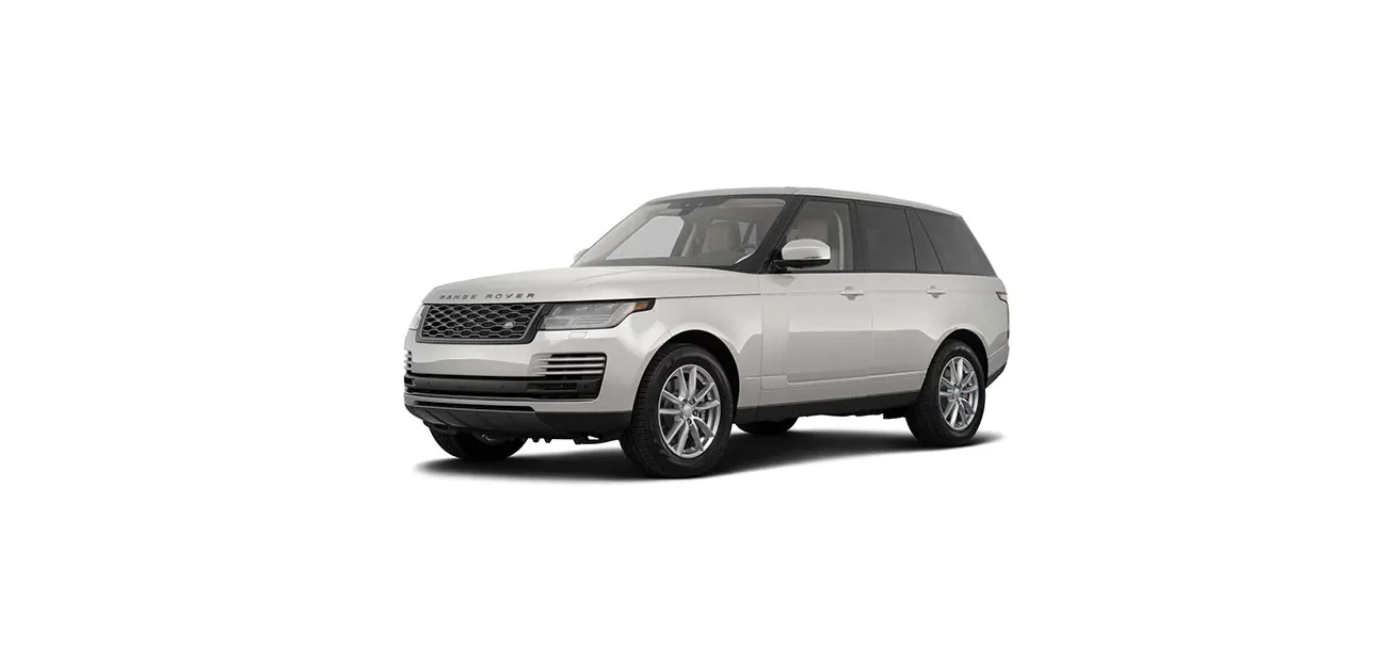2022 Land Rover New Range Rover Entering The Vehicle

SMART KEY OPERATION
SMART KEY
The smart key system uses Radio Frequency (RF) transmissions that could interfere with implanted medical devices. To avoid any possibility of interference between the system and the device, make sure that the device is kept at a safe distance. The distance should be at least 9 in (22 cm) away from any transmitter. In rare circumstances, interference may cause an implanted medical device to malfunction. Malfunction to an implanted medical device may potentially cause serious injury or death.
See SMART KEY SYSTEM TRANSMITTERS.
To prevent accidental or unauthorized operation, never leave children or animals unattended in the vehicle. The vehicle can be operated when the smart key is inside the vehicle. Unauthorized operation may lead to serious injury or death.
The operational range of the smart key varies considerably, depending on atmospheric conditions and interference from other transmitting devices.
If any door, or the tailgate, is unlocked ten times within a short period, the locking latch disables for approximately 1 minute.
A replacement smart key can be obtained only from a retailer/authorized repairer. The retailer/authorized repairer requires proof of identification and ownership. Notify a retailer/authorized repairer immediately if a smart key is lost or stolen.
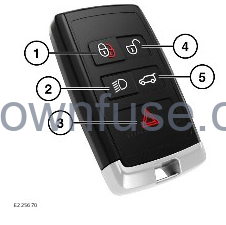
The vehicle is supplied with two smart keys. The smart keys act as remote controls for the locking and alarm systems. The smart keys allow the vehicle to be locked, unlocked, and driven without the use of a conventional key. Each smart key also contains a slide-off emergency key. See KEYLESS ENTRY, KEYLESS LOCKING and STARTING THE ENGINE.
- Lock: Press to secure the vehicle. The vehicle single locks. If power-fold mirrors are enabled, the mirrors fold in. See SINGLE LOCKING and DOOR MIRRORS.
- Approach illumination: When approaching the vehicle during darkness, press to switch on the headlights for approach illumination. Press again to switch the approach illumination off. The approach illumination preset delay period is 30 seconds. Configure the delay period to provide illumination lasting between 0 seconds and 4 minutes via the Vehicle sub-menu in SYSTEM SETTINGS. See SYSTEM SETTINGS.
- Panic alarm: Press and hold for 3 seconds, or press three times within 3 seconds, to activate the horn and the hazard warning lights. Once active for more than 5 seconds, the alarm can be canceled. Press the button and hold for 3 seconds, or press three times within 3 seconds. The panic alarm also cancels if a valid smart key is present when the START/STOP button is pressed.
- Unlock: Press briefly to unlock the vehicle and disarm the alarm. The hazard warning lights flash twice to indicate that the vehicle is unlocked and the alarm is disarmed. The interior lights illuminate to assist entry to the vehicle. If power-fold mirrors are enabled, the mirrors unfold.
- Tailgate: Press briefly to release, open, or close the tailgate. If the vehicle is locked and armed, all of the other doors remain closed and the exterior alarm remains armed while the tailgate is open. Intrusion and inclination sensing systems disable until the tailgate is closed again. When closing, if the vehicle is already locked and armed, the hazard warning lights flash after a few seconds. The hazard warning lights confirm that the full alarm system is re-armed. An audible tone sounds when the vehicle is locked.
NOTES
Make sure the smart key does not remain in the vehicle before closing the tailgate. The smart key may not be detected if it is inside a metal container, or shielded by a device with a back-lit LCD screen. For example, a smartphone, laptop, including when inside a laptop bag, or a games console. Also, if the vehicle is in an area of localized RF interference, the smart key may not be detected. If the smart key is not detected inside the vehicle, the vehicle can be locked. The vehicle does not automatically unlock. The vehicle unlocks only with another valid smart key.
The security system disarms automatically when the vehicle is unlocked with a smart key. However, if a door is not opened within 40 seconds, the security system re-engages the locks and the alarm re-arms. Automatic re-locking and re-arming is a precautionary action to protect the vehicle when it is unintentionally left unlocked.
A replacement smart key can be obtained only from a retailer/authorized repairer. The retailer/authorized repairer requires proof of identification and vehicle ownership.
Notify a retailer/authorized repairer immediately if a smart key is lost or stolen.
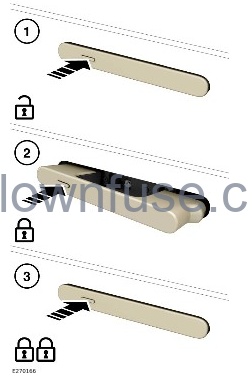
- Keyless unlock: Press to unlock and disarm the vehicle. The door handles deploy on all unlocked doors.
NOTES
A handle in the deployed position indicates an unlocked door. - Keyless single lock: Press the lock button on the door handle to single lock the vehicle. See SINGLE LOCKING.
NOTES
A handle in the retracted flush position indicates a locked door or a vehicle speed above 5 mph (8 km/h). - The door handle retracts to a flush position.
Handle retraction is a two stage operation.
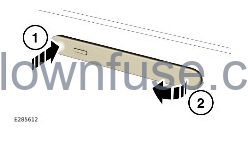
To open door if doors are unlocked and handles are in their retracted position:
- Press the forward part of the door handle (1) to present the rear of the handle.
- Pull the rear of the handle (2) to open door.
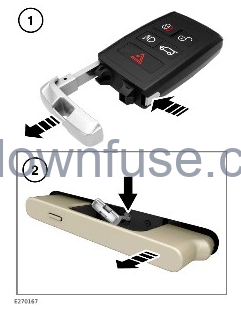
- Emergency key blade access: Push the release button and pull to withdraw the key blade.
- Emergency door unlock: If the smart key and keyless entry fail to open the vehicle, insert the key blade into the lock barrel behind the driver’s door handle. To access the lock barrel, push on the front end of the handle, which presents the rear of the handle. Pull the handle out to the deployed position to give access to the lock barrel. Turn the key blade towards the front of the vehicle and release to unlock.
CAUTION
Make sure that the key is inserted in the orientation shown above. Failure to do so may result in damage to the vehicle’s paintwork.To unlock, turn the key blade clockwise and release. The alarm sounds if the door is unlocked until the smart key is positioned correctly to disarm the alarm. The alarm also sounds if the unlock button is pressed on the smart key. See EMERGENCY LOCKING.
To lock, turn the key blade towards the rear of the vehicle and release.
NOTES
The operation locks all of the doors, but does not arm the alarm.
2-STAGE UNLOCKING
To unlock the vehicle and disarm the alarm system, press the smart key’s unlock button.
The vehicle unlocks in one of two ways:
- 2-stage unlocking on: Unlocks the driver’s door only. A second press is required to unlock the remaining doors and the tailgate.
- 2-stage unlocking off: Unlocks all of the doors and the tailgate on the first press.
To change the vehicle’s 2-stage unlocking status, press the smart key’s lock and unlock buttons simultaneously for 3 seconds. The hazard warning lights flash twice to confirm the change.
2-stage unlocking can also be set via the Vehicle menu in the SYSTEM SETTINGS screen. See SYSTEM SETTINGS.
If an audible warning sounds when the vehicle is unlocked, there may be a fault with the alarm sensors. Consult a retailer/authorized repairer as soon as possible.
APPROACH UNLOCKING
This feature is not available on your vehicle at this time.
KEYLESS ENTRY
The smart key system uses Radio Frequency (RF) transmissions that could interfere with implanted medical devices. Make sure that the device is kept at a safe distance of at least 9 in (22 cm) away from any transmitter. This is to avoid any possibility of interference between the system and the device. The RFs and field strengths used by the keyless entry system operate well within required medical standards for radiated emissions. In rare circumstances, interference may cause an implanted medical device to malfunction, potentially resulting in serious injury or death.
For information concerning the location of the security system transmitters, see SMART KEY TRANSMITTER LOCATIONS.
The smart key may not be detected if it is shielded by metal and/or devices with LCD screens. For example, a smartphone, a laptop or a games console. Keep the smart key clear of such devices when attempting keyless entry, keyless locking, or push button starting.
The smart key only needs to be on the driver’s person, or in a nearby non-metallic bag or briefcase. The smart key does not need to be exposed or handled.
Keyless entry allows the vehicle to be opened if a smart key is within 60 in (1.5 m) of the door handle or taildoor button.
The keyless entry system activates when the keyless unlock button on the door handle is pressed. Grip and pull the door handle to open the door. The vehicle unlocks, the alarm system disarms, and the hazard warning lights will flash twice to confirm unlocking. If the power-fold mirrors are enabled, the mirrors fold out.
When 2-stage unlocking is the current security setting and a door other than the driver’s door is opened first, all of the doors will unlock.
After entering the vehicle, and closing all of the doors, the vehicle scans the interior for a valid smart key. If a valid smart key is not detected, the instrument panel displays a warning message. If this situation occurs, use a valid smart key to carry out the engine start backup procedure. See ENGINE START BACKUP.
ACTIVITY KEY
The activity key system uses Radio Frequency (RF) transmissions that could interfere with implanted medical devices. Make sure that any susceptible medical devices are kept at a safe distance of at least 9 in (22 cm) away from any transmitter. Maintaining this distance avoids any possibility of interference between the system and the medical device. The RFs and field strengths used by the keyless entry system operate well within required medical standards for radiated emissions. In rare circumstances, interference may cause an implanted medical device to malfunction, potentially resulting in serious injury or death. See SMART KEY SYSTEM TRANSMITTERS.
The activity key is a touchscreen wristwatch. The activity key is designed to support situations where the smart key might be obtrusive or difficult to keep secure. The activity key is waterproof to a depth of 131 ft (40 m) and is shockproof. Care should be taken during certain sporting activities, e.g., skiing, jet-skiing, or diving, to protect the activity key.
The activity key provides full keyless entry and keyless start functionality. See KEYLESS ENTRY, KEYLESS LOCKING and STARTING THE ENGINE.
When the activity key is activated, the vehicle locks, the alarm system arms, and any smart key remaining inside the vehicle is disabled.
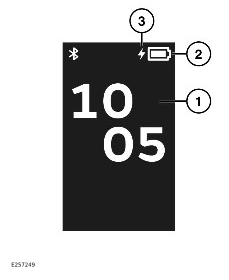
The home screen displays the current time (1). Press and hold the screen for approximately two seconds to wake the home screen. Swipe downwards to bring up the next menu item. Swipe right to select the current menu item.
The battery charge level (2) is shown in the top right of the screen. If the activity key battery charge level drops below 30%, the screen displays a prompt to charge the activity key. The screen disables if charge drops below 25% to preserve functionality.
When left idle for a period of time, the activity key’s touchscreen switches off to preserve battery power.
The charge icon (3) is displayed when the activity key is being charged. A magnetic USB charge cable is supplied with the activity key to enable charging. Replacement charge cables are available from retailers or authorized repairers.
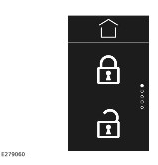
The vehicle must be switched off. After exiting the vehicle and closing the last open door, swipe upwards to access the activity key’s Locking menu. Press the lock icon to lock the vehicle. The hazard warning lights flash to confirm. If power-fold mirrors are enabled, they will fold in. Touch the home icon to return to the home screen.
If a locking attempt is unsuccessful, an audible alert sounds. Check that all of the doors and the tailgate are closed, and that the vehicle is switched off.
If the tailgate of a locked vehicle is opened using the smart key, an audible alert may sound when re-closing the tailgate. Should this occur, fully unlock the vehicle before attempting to close the tailgate.
When the vehicle is locked with the activity key, any valid smart key remaining inside the vehicle is disabled. Any valid smart key outside the vehicle remains enabled.
On returning to the vehicle, swipe upwards to access the activity key’s Locking menu. Press the unlock icon to unlock and disarm the alarm system. The hazard warning lights flash to confirm. If the power-fold mirrors are enabled, they unfold.
When the vehicle is unlocked with the activity key, any valid smart key inside the vehicle re-enables.
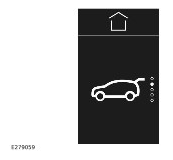
The luggage compartment can be opened using the activity key. Swipe up from the home screen until the tailgate-trunk icon is shown. Press the icon to open the tailgate or trunk. If power tailgate is fitted, the tailgate will open fully. Press again to close the tailgate.

To sound the alarm, swipe up from the home screen until the hazard warning triangle is displayed. Press the triangle to sound the vehicle’s alarm. Press again to switch off. Alternatively, briefly touch the home screen three times in quick succession.
The panic alarm cannot be canceled during the first 5 seconds of operation. Once this 5 seconds has passed, the panic function on the smart key will de-activate the panic alarm.

Wet mode inhibits the screen to prevent accidental operation when submerged in water, or subjected to water splashes. Swipe up from the home screen until the water drop symbol is displayed. Press the drop to activate wet mode. To exit wet mode, touch the screen four times in quick succession. A progress bar confirms screen touches until the screen is unlocked.
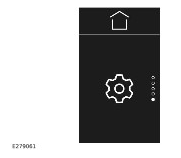
Swipe up from the home screen until the Settings cog wheel is displayed. Pressing the cog wheel will display a clock face icon, from which the displayed time can be adjusted.
GLOBAL OPENING
Global opening of the windows can be enabled and disabled via the Vehicle menu . See SYSTEM SETTINGS.
To unlock the vehicle and open all of the windows simultaneously, press and hold the smart key’s unlock button for 3 seconds. See SMART KEY OPERATION.
To cancel global opening, press any of the buttons on the smart key.
CONVENIENCE MODE
When the driver’s door is opened using either the smart key or keyless entry, the vehicle’s electrical system initiates convenience mode. The following systems become functional:
- Seat position memory.
- Seat and steering column adjustment.
- Interior and exterior lighting.
- Instrument panel.
- Auxiliary power sockets.
SMART KEY SYSTEM TRANSMITTERS
For more information on the locations of the security system transmitters, see SMART KEY TRANSMITTER LOCATIONS.
OPENING AND CLOSING THE POWERED TAILGATE
The powered tailgate incorporates a soft-close latch. The soft-close latch secures the tailgate automatically. Before operating the tailgate, make sure that the area is clear and anyone in the vicinity does not have any body part in a position where it could be trapped. Note that the soft close action does not incorporate object detection. Death or serious injury could occur, even with an object detection system.
While the tailgate is open, the locking latch is exposed. Do not attempt to manually close the latch, as it may also automatically soft-close and trap items or body parts.
Make sure that there is sufficient space above and at the rear of the vehicle before operating the tailgate. Insufficient opening space may result in damage to the vehicle.
Do not operate the tailgate if a cycle rack is fitted to the tailgate. Remove any cycles and/or racks before operating the tailgate. Cycles and/or racks may cause interference in the operation of the tailgate.
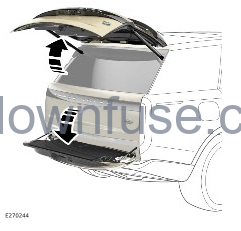
Tailgate open or close:
- Press the button on the bottom of the upper tailgate to open the upper tailgate.
- Press the button on the top of the lower tailgate to drop the lower tailgate.
- With both upper and lower tailgates opened, the open-close button on the upper tailgate will close both the lower and upper tailgate.
The upper tailgate button operates when all of the doors are unlocked and the gear selector is in the Park (P) position. If the gear selector is in the Neutral (N) position, the button operates only if all of the doors are unlocked. The button also operates if the ignition is in convenience mode or switched off. The tailgate button does not operate if the gear selector is in any other position. See CONVENIENCE MODE.
The powered tailgate can also be opened or closed using the following methods:
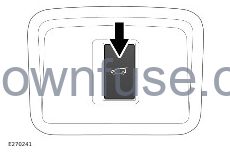
- The interior tailgate release button. See DRIVER CONTROLS.
- The smart key’s tailgate release button. See SMART KEY OPERATION.
After the tailgate has opened to its set height, it can be manually raised or lowered. If the tailgate fails to open or close correctly, close it manually and then press the tailgate release button again.
As the closing tailgate approaches the closed position, it soft-closes to the fully closed position. If the vehicle was previously locked, the alarm re-arms. The hazard warning lights flash to confirm the alarm status. An audible confirmation may also be given.
If a tailgate button is pressed while the tailgate is opening or closing, all movement stops. However, if a button is pressed during the soft-close stage, the request is ignored.
Object detection while opening: If an object is detected that would interfere with the tailgate opening, tailgate movement stops. Remove any obstructions. Press the tailgate button again to open.
Object detection while closing: If an object is detected that would interfere with the tailgate closing, tailgate movement stops. The tailgate then reverses to the fully open position, if able to do so. An audible warning sounds to indicate a mislock. If the tailgate is open, remove any obstructions. Press the tailgate button again to close the tailgate. If the tailgate is not open, press a tailgate release button to open the tailgate. Remove any obstructions. Once the obstructions have been removed, press the tailgate close button to close the tailgate.
If a valid smart key cannot be detected within 39 in (1 m) of the rear of the vehicle, the tailgate does not power-close. An audible warning sounds to indicate a mislock.
If the smart key remains inside the vehicle when the vehicle is locked and the alarm is set, an audible warning sounds. The warning indicates a mislock and the tailgate re-opens after approximately 3 seconds. The smart key may not be detected if it is inside a metal container, or is shielded by a device with a back-lit LCD screen. For example, a smartphone laptop, including when inside a bag, or a games console.
Tailgate event suite allows media to be played through the loadspace speakers for an extended period using an extended battery capacity. See TAILGATE EVENT SUITE.
TAILGATE OPENING HEIGHT
The maximum opening height for the tailgate can be set as required. Setting a maximum height is useful in parking areas with very low roofs, or just for ease of use.
To set the maximum height as required:
- Open the powered tailgate to the position required as the maximum height. Press any tailgate release button to stop movement at the required position. The final position can be achieved manually, if required.
- Make sure the tailgate is stationary for at least 3 seconds.
- Press and hold the tailgate close button for greater than 5 seconds, or until an audible confirmation is heard, to set the required opening height. Release the tailgate close button.
- Close the tailgate, then open again to check that it opens to the set height. See OPENING AND CLOSING THE POWERED TAILGATE.
- The maximum opening height is now set.
If, after performing part 3 of the process, the tailgate closes automatically, the required height has not been set. Repeat the process, making sure that all steps are adhered to.
To reset the maximum opening height, repeat the process, but when the tailgate reaches its current set height, manually move it to the fully open position before pressing and holding the tailgate close button.
The tailgate may lose its position memory if there are multiple object detections, or if the battery voltage is low. Powered operation may also be inhibited.
To reset the tailgate:
- Manually close the tailgate.
- Press the tailgate release button.
- Allow the tailgate to fully open or open to the previously set position.
- Press and release the tailgate button.
- Allow the tailgate to power-close fully. The tailgate’s programmed memory is restored.
GESTURE TAILGATE
Make sure that the standing area is stable and not slippery before performing the kick movement, to avoid serious injury or death.
Do not make contact with the vehicle exhaust, as it may be hot. Touching the hot vehicle exhaust could result in an accident, leading to serious injury or death.
Make sure that there is sufficient space above and at the rear of the vehicle before operating the tailgate. Insufficient opening space may result in damage to the vehicle.
Do not operate the tailgate if a cycle rack is fitted to the tailgate. Remove any cycles and/or racks before operating the tailgate.
The gesture action is a smooth kick and return motion, not a swipe motion.
The operation of the gesture tailgate may vary depending on the vehicle’s suspension height.
If the ignition is switched on, the tailgate operates but the turn signals do not flash.
A valid smart key must be within 39 in (1 m) of the tailgate. The smart key may not be detected in a metal container, or if it is shielded by a device with a back-lit LCD screen. For example, a smartphone, laptop, including when inside a laptop bag, or a games console. Keep the smart key clear of such devices when attempting hands-free operation of the powered tailgate.
Certain conditions may affect the performance of the sensors, and movement beneath the bumper may not be detected. If this should happen, use the interior tailgate release switch or the smart key’s tailgate release button. Check the operation of the gesture tailgate when the vehicle is in a new location.
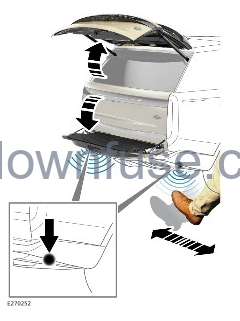
Sensors (if fitted) are positioned within the outer parts of the rear bumper. The sensors recognize a valid kick movement of a foot below the bumper level and allow automatic opening or closing of a powered tailgate.
To operate the gesture tailgate (if fitted), approach the vehicle, and perform a smooth kick and return motion. The kick should last between 1 and 2 seconds and take place within one of the vehicle’s two sensor areas, as illustrated. When the vehicle recognizes a valid kick movement, the turn signals flash and the tailgate operates.
Unintentional operation: In exceptional circumstances, and if the smart key is within 47 in (1.2 m) of the tailgate, the powered tailgate may operate unintentionally due to the following:
- Car washing or high pressure cleaning.
- Moving objects beneath the rear bumper sensors.
- While changing a rear road wheel.
- While fitting snow chains to the rear wheels.
The gesture tailgate feature can be disabled or enabled via the touchscreen as follows:
- Touch the settings icon.¹
- Select ALL.
- Select Power Tailgate.
- Touch the Gesture Tailgate toggle to disable or enable the feature.
- Touch the exit icon.²
Settings icon.¹
Exit icon.²
DRIVE-AWAY LOCKING
Drive-away locking automatically locks all of the doors when the vehicle reaches a set speed. The drive-away locking set speed can be adjusted via Vehicle in the touchscreen menu. See SYSTEM SETTINGS.
After drive-away locking has taken place, press the unlock or lock button to override the feature for the current journey. The unlock and lock buttons are located on the inside of the front doors. See DOOR LOCKS AND HANDLES.
DEPLOYABLE SIDE STEPS
The deployable side steps are full-length steps that are stowed below the side sills and under the vehicle.
When the deployable side step is activated it automatically deploys if any of the doors are opened on the appropriate side. If doors on both sides are opened, both side steps deploy.
The deployable side steps can be set via the touchscreen’s Vehicle menu. See SYSTEM SETTINGS.
The vehicle remembers the set status and a change to the status can be made at any time. When set to On, the side steps are activated in auto mode.
The deployable side steps do not deploy when the vehicle is traveling at more than 3 mph (5 km/h). If the side steps are already deployed, they stow automatically when the vehicle’s speed exceeds 3 mph (5 km/h).
The deployable side steps return to their previous position if an obstruction is encountered during operation. If this occurs, the touchscreen displays a warning.
Make sure the side steps are fully deployed and have completed their operation before stepping on the running boards. Failing to do so can cause the side steps to reverse direction.
After a side step has been deployed, automatic operation is activated after both doors on that side of the vehicle are closed. When the vehicle is unlocked from the outside, the side steps deploy if the deployable side steps menu status is set to On. Operation of the side steps on one or both sides of the vehicle is dependent on the following unlocking status:
- When the smart key is set to single-point entry, on the first press of the smart key, the side step deploys on only the driver’s side. A second press also deploys the passenger side step.
- When the smart key is set to multi-point entry, both side steps deploy.
- Keyless entry deploys both side steps.
When the smart key or keyless entry is used to open the vehicle, and subsequently no door is opened, the side steps automatically stow after 1 minute.
The side steps can be deployed indefinitely to access the roof, cleaning or accessing the jacking points. On the Side steps menu, select Roof access. The electric parking brake must be on and the vehicle unlocked to activate Roof access. The side steps deploy and remain in their deployed position until Roof access is deselected. The deployed position deactivates automatically, and returns to the automatic setting, if the vehicle speed exceeds 3 mph (5 km/h), or if the vehicle’s doors are locked.
Use Roof access mode to enable cleaning of the steps and the underside of the vehicle in a pull-through car wash, follow the steps above to activate Roof access mode. Once in Roof Access mode, release the electic parking brake. The vehicle can now move up to 3 mph (5 km/h) without the side steps stowing.
For more information about vehicle cleaning, see THE EXTERIOR.
To prevent potential damage to side steps, the side steps do not deploy when the vehicle is in following terrain response programs. See TERRAIN RESPONSE OPERATION:
- Sand
- Rock Crawl
- Mud ruts
- Wade (only while in low range wade mode).
Enabling Off-road operation mode allows the deployable side steps to continue operating in the above listed terrain response programs.
Use of Off-road operation mode can result in damage to the vehicle in unsuitable terrain. Make sure there are no obstructions in path of side steps before operating Off-road operation mode.
SMART KEY DEACTIVATION
Key deactivation is intended to secure keys that have been stored in the vehicle. A deactivated key will not start the vehicle. Keys become deactivated when left inside the vehicle when the alarm is armed. For example, if the vehicle is locked by another key, or if keyless locking arms the alarm. Keys become deactivated if left inside the vehicle when closing the tailgate, trunk lid or taildoor while the alarm is armed.
To reactivate a key:
- Start the vehicle using another activated smart key or activity key, or
- Unlock the vehicle using the InControl Remote application.
SMART KEY BATTERY REPLACEMENT
Make sure the following warnings have been read and fully understood before using components with coin or button cell batteries. Failure to follow the guidance could result in serious injury or death.
Chemical burn hazard. Batteries can cause severe internal burns within 2 hours of swallowing and may result in death. If it is suspected that a battery may have been swallowed or placed inside any part of the body, seek medical advice immediately.
Keep new and used batteries away from children.
If the battery compartment does not close securely, stop using the product and keep the product away from children.
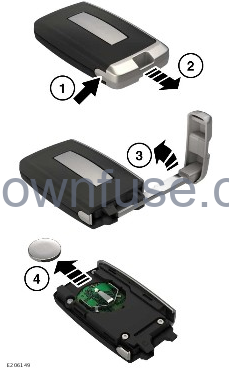
When the battery needs replacing, there is a significant decrease in the effective range and the instrument panel displays Smart Key battery low.
- Push the button on the smart key, to remove the emergency key blade.
- Pull the emergency key blade in the direction of the arrow.
- Use the emergency key blade to separate the smart key’s body.
- Remove the battery and press the upper positive terminal until the negative grid is touched. Upon recovering the position of the terminal, the coin cell shall have firm positive contact with the upper terminal.
- Fit a new and unused CR2032 type battery, available from a retailer/authorized repairer, with the positive (+) side upward.
- For cars with passive entry: after replacing the battery, allow 10 minutes for the internal battery to recharge before testing the smart key function.
Avoid touching the new battery. Moisture or oil from fingers can reduce battery life and corrode the contacts.
Refit the parts in reverse order. Make sure that the parts click securely into place.

Battery disposal: Batteries contain harmful substances and must be disposed of correctly. Seek advice on disposal from a retailer/authorized repairer and/or the local authority.
SMART KEY CARE
To prevent accidental or unauthorized operation, never leave the smart key unattended in the vehicle. Never leave children or animals unattended in the vehicle. The vehicle can be operated when the smart key remains inside the vehicle. Doing so could lead to serious injury or death.
Do not expose the smart key to extremes of heat, dust, or humidity. Do not allow the smart key to come into contact with fluids. Do not leave the smart key exposed to direct sunlight, as it could result in damage to the smart key.
The Radio Frequency (RF) used by the smart key may be used by other devices, e.g., medical equipment. The use of such devices may prevent the smart key from operating correctly.
The emergency key blade number is recorded on an attached label. Peel off the label and keep it safe, but not in the vehicle.
The operational range of the smart key varies considerably, depending on atmospheric conditions and interference from other transmitting devices.
To avoid permanent damage to the smart keys, replace the batteries in all of the smart keys simultaneously when the Smart Key battery low message is displayed.
